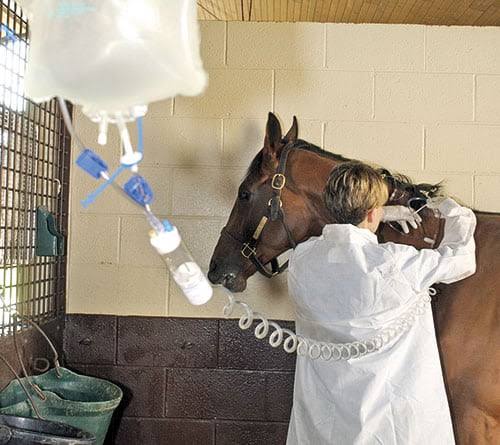One of the main causes of sickness in horses is salmonella. It is one of the illnesses that affect horses the most. This is because horses are high consumers of water.
Therefore, they get more exposure to salmonella than any mammals on the earth. Despite their exposure to this, Salmonella has the power to break down a horse.
Thankfully, this article discusses the steps to follow when you observe salmonella in horses.
How To Treat Salmonella In Horses
Here is a step-by-step process for treating salmonella in horses:
READ MORE: How to Know if a Dog is Pregnant
Step 1: Be Sure To Confirm The Symptoms
Recognising the signs is the first step in treating Salmonella in horses. You are the only person who truly understands the routines and behaviour of your horse. If anything doesn’t seem right, you should be aware of it.
Keep an eye out for symptoms of disease in your horse. Diarrhoea is one of the most common signs of a Salmonella infection. Stools may be the first sign, and watery diarrhoea may follow.
You can also see symptoms of abdominal pain. Another typical symptom is fever. A rectal thermometer can be used to take your horse’s temperature.
A horse’s normal temperature ranges from 99°F to 101.5°F. Something is wrong if you observe that your horse’s temperature rises above this range.
Step 2: Contact Your Veterinarian When You Confirm The Symptoms
Contacting your veterinarian is the next step after you’ve identified your horse’s Salmonella symptoms. Be ready to give your veterinarian specific details about your horse’s symptoms when you chat with them.
Your veterinarian will be able to evaluate the problem more skillfully with this information. Observe if other horses are showing the same symptoms. It might be advised by your veterinarian to get your horse examined. They might suggest laboratory testing in specific circumstances.
Step 3: Follow Veterinary Recommendations
You must adhere to your veterinarian’s directions. To support the fight against the Salmonella infection, they could recommend antibiotics.
The perfect course of action will be determined by your veterinarian after evaluating the particular circumstances of your horse. Supportive care is crucial in many situations. Making sure your horse stays hydrated is one way to do this. 
Dehydration can quickly escalate into a major problem. Thus, keeping an eye on water consumption is essential. Sometimes your veterinarian will prescribe drugs to lower fever and relieve symptoms.
To guarantee the safety of the therapy, it is advisable to adhere to the recommended dosages and administration instructions.
Step 4: Provide Supportive Care At The Range
There are two benefits to caring for a horse with Salmonella at home. Your care and support as a committed owner can have a big impact on your horse’s recuperation. Make your surroundings stress-free and cosy.
To stop the virus from spreading, try to keep him apart from other horses. This is due to the high contagiousness of Salmonella. Make sure he always has access to clean water.
Step 5: Monitor the Progress Of Your Horse and Adjust the Care
Keep a daily log of your horse’s symptoms, behaviour, and any changes in appetite or hydration while you tend to him at home. During follow-up visits, this record may be useful when talking with your veterinarian about your horse’s health.
Do well to look out for recovery, such as a decrease in diarrhoea, an increase in energy, and a return of appetite. However, get in touch with your veterinarian once your horse’s condition deteriorates.
It is very important to keep in mind that recovering from Salmonella may require some time. While some horses might recover fast, others might need more attention.
Step 6: Prevent Future Infections
Take precautions to avoid recurrent infections after your horse has recovered from Salmonella. To lower the danger of bacterial illnesses in horses, it is important to keep the surroundings clean and healthy.
To reduce the amount of dangerous bacteria, it is advisable to routinely clean and disinfect water buckets and feeding equipment. Never let your horse drink from stagnant sources. Instead, make sure he always has access to clean water.





One thought on “How to Treat Salmonella in Horses”